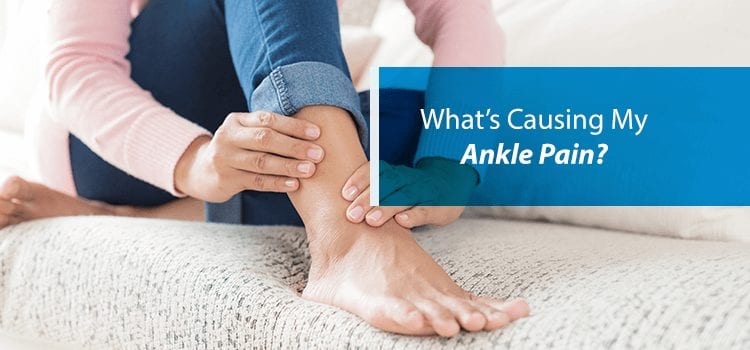Generally speaking, people associate ankle pain with athletes. That’s certainly a fair observation. After all, strains and sprains are some of the most common injuries to befall both athletes and the ankle. This only makes sense considering how crucially the ankle functions in executing our everyday activities like walking. For example, consider the many instances in which an athlete may need to shift suddenly or pivot directions—two actions that apply a ton of stress on the ankle. If one lands the wrong way while doing so, it can easily precipitate an injury.
But, ankle ailments are not specific to athletes. In fact, strains and sprains—while common—represent only the tip of the iceberg when it comes to sources of ankle pain.
Remember: The ankle bears extremely high stress and heavy weight relative to its size. This creates a perfect storm when it comes to developing arthritis. Moreover, with any joint, there is always the looming threat of infection, tendonitis, bursitis, and much more. It’s all a natural consequence of being a part of a mechanical system that is designed to move about and bear loads. Eventually, all moving parts of the body wear down. It’s just a natural byproduct of physics and the aging process.
Thankfully, wherever there’s a potential medical problem, there also exists preventive measurements and effective treatment care plans. Of course, problems with the ankle are no different. Patients will find that there are plenty of routes to take when it comes to treatment—both surgical and conservative. What ends up being right for you, however, will depend heavily on the nature of your individual case. To find out what works best for your situation, make an appointment with NJ Spine & Orthopedic today!

Common Causes of Ankle Pain
Pain, in and of itself, is a very broad topic. As such, you can expect to encounter a very large list of probable causes as underlying forces that contribute to ankle pain. That being said, there are some common threads and trends that we can observe in such cases. Here are some common culprits that cause ankle pain:
- Flat Feet: This is a deformity that presents itself during early child development. People with flat feet either have no natural arch in their foot; or, if there is one present, then it is very low. Under normal circumstances, the arches in our feet help to distribute body weight. The absence of these arches may lead to ankle pain in later life as weight is incorrectly distributed.
- Ankle Fractures & Breaks: This is an injury to the bones in the ankle that may occur as a result of a fall, car accident, or contact sports.
- Ankle Sprains & Strains: A lot of people think these two conditions are synonymous, but they differ slightly. A sprain involves overstretching or tearing ligaments, whereas a strain is the same but instead involves torn muscles or tendons.
- Bursitis: Surrounding the joints are small, fluid-filled sacs that doctors refer to as the bursae. These structures cushion the bones, tendons, and muscles adjacent to the body’s larger joints (the ankle being no exception). If a joint sustains repetitive stress over a period of time, it may lead to inflammation of the bursae and painful symptoms.
- Achilles Tendinitis: This condition occurs when the Achilles tendon becomes inflamed as a result of repetitive stress.
The Ankle & Arthritis
Simply put, arthritis in the ankle can assume many forms. Such examples include:
- Gout: Usually affects the big toe, but there are also many cases of gout manifesting in the ankle. Gout typically involves a sudden onset of intense pain, swelling, and redness in the affected area.
- Ankylosing Spondylitis (AS): This is an inflammatory disease in the spine that, if left untreated, will cause the vertebrae to fuse together. In rare cases, AS will cause pain in other joints of the body, such as the knees and ankles.
- Ankle Osteoarthritis: A degenerative disease that occurs when a joint’s protective cartilage wears down during the natural aging process.
- Reactive Arthritis: This form of arthritis sometimes appears as a byproduct of an infection elsewhere in the body (such as the intestines or urinary tract).
- Septic Arthritis: Inflammation from septic arthritis is the direct result of foreign invaders in the body such as viruses, bacteria, or fungi.

Diagnosing Ankle Pain
Your doctor will begin the diagnostic process with a series of questions that will help him or her determine the nature of your symptoms. For example, he or she will want to know if your pain occurred with an acute, sudden onset or if it has been chronic and aching. Your doctor will also perform a physical examination, which will involve applying pressure to the area and moving the joint in different directions.
By this point, your doctor will likely have achieved a rough idea of what’s going on. That being said, he or she may wish to confirm their suspicions through further imaging tests. Common imaging techniques that doctors use for diagnosing ankle problems include:
- X-rays
- CAT scans
- MRIs
- Bone scans
In some instances, your doctor may request a blood sample. The contents of your blood will provide your doctor with a reserve of useful diagnostic information. For example, high levels of antinuclear antibodies may suggest the presence of lupus or another inflammatory disease. Additionally, blood tests will also reveal any rheumatoid factors, as well as the presence of uric acid and creatinine (which suggest gout).
Your doctor may consider drawing fluid from the suspect joint. Using a microscope, your physician will be able to detect the presence of urate crystals, thereby confirming a gout diagnosis.
Ultimately, the route your doctor takes will be contingent on your initial questionnaire as well as findings from your physical examination.
Ankle Pain & Conservative Treatments
There are a wide variety of conservative and surgical treatment approaches that address ankle pain. Usually, your doctor will attempt nonsurgical methods before considering any kind of procedure. Only after conservative options have been exhausted will your physician consider surgery. Nonsurgical treatments for ankle pain may include:
- Pain Medications: In many instances, over-the-counter or prescription NSAIDs will reduce both pain and inflammation down to manageable levels.
- Physical Therapy: Ankles are tough to rehabilitate, so buddy up with a trained physical therapist on this one. He or she will give you a list of special exercises to perform that are tailor-made to address your specific situation.
- RICE Method: A tried-and-true method of immediate treatment for ankle injuries such as sprains and strains. RICE stands for rest, ice, compression, and elevation. It’s exactly what it says on the tin. Rest the ankle, apply ice, wrap the area with an elastic medical bandage (not too tightly), and elevate the affected area above the heart.

Ankle Surgeries to Eliminate Ankle Pain
If you require surgery to reverse your condition, your doctor will use minimally invasive methods (whenever indicated) to resolve your pain. Common procedures that doctors perform to treat ankle pain include:
- Ankle Fusion: Doctors use this procedure to treat arthritis in the ankle. It involves fusing the bones of the ankle into a single, solid strip of bone in order to eliminate painful movement.
- Ankle Arthroscopy: During this procedure, doctors use a special instrument called an arthroscope to visualize ankle tissue. An arthroscope is a fiber-optic viewing camera that your doctor can insert into the affected area via small incisions. The camera feeds live footage to a nearby monitor, which then shows the doctor relevant anatomy, such as floating debris from torn cartilage.
- Ankle Reconstruction Surgery: Doctors use this procedure to treat complete ligament tears. They may accomplish this feat by reattaching and tightening the ligaments or by replacing the ligament outright using a donor or partial portion of the surrounding lateral tendons.
If conservative treatments have not eliminated your ankle pain, please contact NJ Spine & Orthopedic at (855) 586-2615. Our highly trained foot doctors are passionate about putting you on a treatment plan that suits your specific needs. Leave your ankle pain behind you and contact us today!

